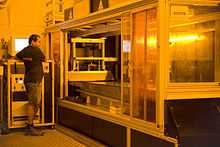Materialise NV
 | |
| Public | |
| Traded as | NASDAQ: MTLS |
| Industry | 3D Printing |
| Founded | 1990 |
| Founder | Wilfried Vancraen |
| Headquarters | Leuven, Belgium |
Area served | Worldwide |
Number of employees | 1000+ |
| Website | http://www.materialise.com/ |
Materialise NV, headquartered in Leuven, Belgium, is active in the field of additive manufacturing, also known as 3D Printing.
History
Materialise was founded in June 1990 by Wilfried Vancraen as a spin-off of the KU Leuven, becoming the first Rapid Prototyping Service Bureau in the Benelux region.[1] What was then known as Rapid Prototyping is now known as Additive Manufacturing or 3D Printing, a three-dimensional printing technique that starts from a 3D CAD drawing and results in a three-dimensional object manufactured in a wide range of plastics, stainless steel, titanium, and a growing range of other materials.[2]
Since its foundation, Materialise has steadily grown and today has offices in many countries on five continents. Major offices are in Belgium (HQ), Ukraine and Malaysia. In 2014, Materialise made an IPO at NASDAQ, where it is currently the only represented Belgian company.
Software
Following its conception, Materialise concentrated on the research and development of solutions for the transfer of data to Additive Manufacturing machines. In 1991, the company released Mimics and in 1992, Magics. Mimics calculates surface 3D models from stacked image data such as Computed Tomography (CT), Confocal Microscopy, Micro CT, and Magnetic Resonance Imaging (MRI) through image segmentation. Magics imports data from CAD formats and exports 3D printable files in the STL format.
Service center
Materialise runs the biggest 3D printing service in Europe. It encompasses over 100 machines, producing more than 300,000 parts per year. Offered manufacturing processes include Selective Laser Sintering, Stereolithography, Fused deposition modeling, multi-jet modeling and vacuum casting (with 3D printed casts).
There are two types of business in the service center. Some customers order parts for themselves. These can either be prototypes or functional parts. On the other hand, designers can upload designs to the i.materialise 3D printing marketplace. End customers can then order those designs.
Biomedical engineering
Materialise is active in the field of biomedical engineering. Main fields of application are orthopedic insoles, surgical boring aids and physical replica of internal organs based on CT or MRI data.
Mammoth stereolithography

In order to build single-piece Stereolithography models with dimensions of more than 2 meters, Materialise developed Mammoth Stereolithography. The build area of the largest Mammoth machine is 2100x700x800mm. Applications include a replica of King Tut's body, based on CT data, producing what could otherwise only be seen by unwrapping the mummy.
Applications
The technology at Materialise is being used by professionals in the automotive,[3] aerospace, consumer electronics, consumables, orthopaedic, cardiovascular,[4] cranio-maxillofacial,[5] and dental industries, as well as in architecture, fashion, jewelry, art,[6] and more.
See also
- 3D Printing Marketplace
- 3DLT
- Sketchfab
- Sculpteo
- Shapeways
- Thingiverse
References
- ↑ Society of Manufacturing Engineers. "Wilfried Vancraen Accepts RTAM Industry Achievement Award". Retrieved 14 November 2011.
- ↑ Materialise. "Low Volume Manufacturing Materials List". Retrieved 14 November 2011.
- ↑ Barry, Keith (16 February 2011). "The Secret World of Printing Concept Cars in 3-D". Autopia (Wired).
- ↑ Bongert, M. "Mimics Assists in Investigating Impact of Aortic Valve Prostheses on Blood Flow".
- ↑ Synthes. "CMF Customized Surgical Solutions".
- ↑ Swengley, Nicole (08/09/2011). "New dimension: 3D printing machines". The Telegraph. Check date values in:
|date=(help)